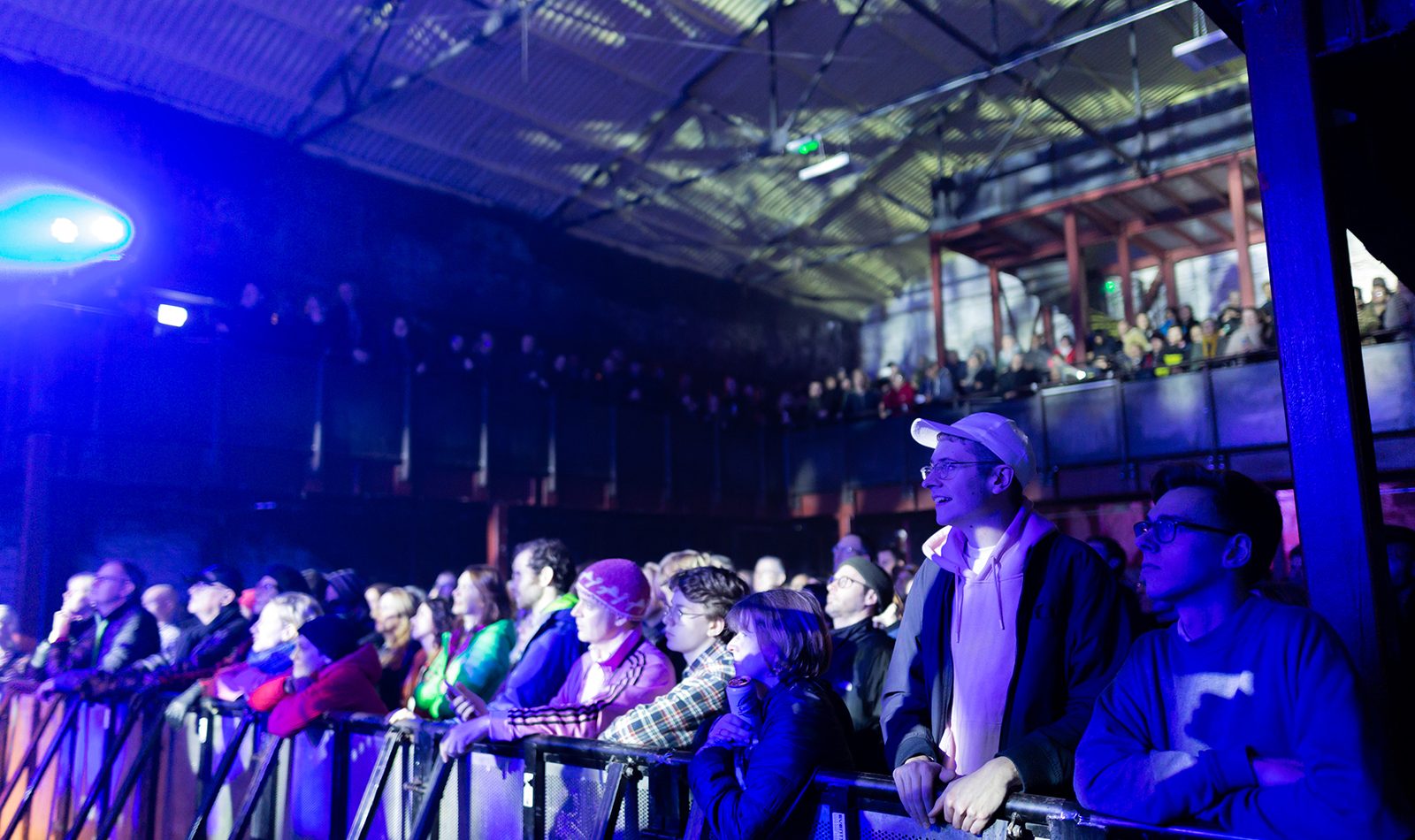The brilliant writer Jude Rogers joined us over a period of months to discover what made us tick. We are truly grateful to her for delving into our world..
A dark warehouse in Bristol on a Friday night. Dry ice and blue light. A synthesiser is in the middle of the stage, taking in all the instruments making sounds around it. The music of Ligeti is pulsing through the crowd. The music of Kraftwerk follows it, being reshaped and recalibrated, reconnecting with the fans and the ravers, firing their blood, souls and sinews.
An elegant art gallery in rural Somerset. Musicians are disseminated around the rooms. The walls are hung with weathered blankets, showing the effects of time and season on the material. Sounds slowly emerge: strange pastoral drones suggesting the motions of the day, low woodwind flutterings suggesting the passing of time. The art gallery becomes a wider, more inquisitive world.
A concert theatre in Perth, Western Australia. Dancers and classical performers come together on stage, looping, intertwining, every boundary being broken between music and movement. A live score by Will Gregory accompanies them, and the audience move amongst it all, experiencing performance in a deeper, more emotional way.
A packed field at the Glastonbury Festival on a sweltering Saturday afternoon. The songs of Barry White ascend, descend and sweat from the stage. Well-known music-makers blend in with others lesser-known to the audience, but in this moment, and in the full beam of reality, these distinctions don’t matter. They have never mattered. All that does is that music is what music is, swelling and bubbling over, transporting us completely.
And all of these musical experiences – every breath, note and dynamic of them – is the work of just one orchestra. One extraordinary, exploratory, adventurous orchestra. They’re an orchestra that understands what an orchestra should be in the 21st century, reaching out into the lives of its players and performers. Then they go beyond that to the people experiencing their music, then out into the world.
They’re an orchestra knows how important it is to connect with many broader audiences, regardless of ability, class, creed or colour. They broaden, balloon and bust the ideas of what an orchestra can do – or rather what music can do, and what can be done.
This is the story of the Paraorchestra. They’re very pleased to have you here.
***
To get a handle on what the Paraorchestra do, it’s best first to understand the incredible energy fizzing at its heart. Backstage at Bristol’s Marble Factory – a former Victorian warehouse voted DJ Magazine’s UK club of the year – conductor Charles Hazlewood and Paraorchestra CEO Jonathan Harper are whizzing around. I’ve been a music journalist covering pop, folk, classical, jazz and everything else for over fifteen years, and I’ve rarely seen their particular kind enthusiasm and exuberance. “We’ve got kraftwerk re:werk one night, we’ve just come back from New York, then there was the Death & Dying Festival at Glastonbury, then in the New Year, there’s Australia more dates in the UK, then the conversations we’re having internationally…” Charles is all flashing eyes and whirligig limbs. “We can’t wait!” says Jonathan, interrupting, bursting with excitement.
As tonight’s performers arrive, Hazlewood lays out the Paraorchestra’s mission, and the context behind it. “Classical music has always been presented as an ivory tower experience for a particular tribe of people. Their education and income bracket is prescribed; that music is treated like their preserve. God forbid the great unwashed would want to enjoy this stuff.” Then there are rigid traditions of how you’re meant to behave around classical music: where you clap, how you clap, whether you should bring sweets or not, or bring children, all of which all feels repressive. “And the fact of the matter is this: guidelines go totally against what music is. Music is the single greatest act of love we have as a species. Making music is about sending love to whoever listening to it – it’s a simple act of communication. Plus it’s a birth-right for all people.”
“So let’s free up the orchestra from these ridiculous confines.” You can’t stop him now. “People find orchestras in their front rooms all the time anyway – in movies, on TV, in computer games – let’s give them the live, visceral rush of experiencing one.” He pauses for breath, smiling, and bursts into laughter.
All that said, the Paraorchestra’s work isn’t just about breaking down boundaries with audience. It’s also about refreshing the orchestral repertoire and expanding what an orchestra looks like. Take tonight’s Kraftwerk Re:werk, composed by Paraorchestra founder member/clarinettist, and now their Associate Music Director, Lloyd Coleman alongside saxophonist/composer Charlotte Harding. Together, they’ve deconstructed the German group’s ground-breaking 1977 album, Trans-Europe Express, before powerfully stitching it back together. At the gig, every instrument in the orchestra is closely miked, including Lloyd’s clarinet; Charlotte then filters and crushes the sounds being made live, improvising in brilliant ways.
New commissions that interact with broader pop culture have been orchestral priorities since Day One. They’ve explored Terry Riley’s In C and Philip Glass’ takes on David Bowie’s Low and “Heroes!”. There was Thunderbirds Are Go! in 2016, led by Jarvis Cocker and Paraorchestra singer Victoria Oruwari, celebrating British composer Barry Gray’s music for TV. A year later came Play!, exploring computer and video game soundtracks. These works allowed a broader range of musicians to be part of the gang. “We’ve needed to refresh the make-up of the orchestra for years,” Charles adds in the green room. “It hasn’t changed in over a century. New commissions allow new technologies and more unusual instruments to be part of the mix.”
This doesn’t mean orchestras should stop playing Beethoven and Brahms, he says. “Far from it. But it does show that we should also be opening doors to a plethora of new technologies, new sounds, and new worlds.”
Some of the Paraorchestra’s longest-standing performers are playing tonight. Clarence Adoo was a founder member: he remembers meeting up with Charles Hazlewood and Lloyd Coleman in a Central London in 2012, and the remit being “to just play. Between ourselves we were putting forward ideas, telling each other what we could do. It felt very different.” Then, Clarence played an instrument called HeadSpace; now he plays the Hi-Note, an instrument that uses breath control to create dynamics, movement, and head movement to change notes and timbres.
What struck him then, as it does now, is how liberating it feels to have so many musicians coming together from many different perspectives in the Paraorchestra. “Many of us didn’t have those opportunities before, and musically, it’s very exciting. We play lots of different venues, and are able to experience so many new kinds of music. All of our musical experience is called upon, above everything. That feels very special.”
Viola player Takashi Kakuchi agrees. He came to London from Tokyo to study in the Royal Academy, before joining the Inner Vision Orchestra, then the Paraorchestra in 2012. “Many windows get opened through the Paraorchestra,” he says. “Musicians get so much support, whatever they need, make music, and to travel.” He’s also loved improving his improvisation skills, he says, which is a big part of the Paraorchestra’s musical ethos: it helps the musicians themselves to feel ownership of the works. He’s also loved dipping into music he’s never experienced before – like Kraftwerk’s for instance. Tonight’s show, he says, smiling, “is a very enjoyable one.”
Three hours later, Takashi is stage-front, his viola being manipulated through Charlotte’s all-powerful filters. Clarence is stage-right, doubling up on the bassline. The sound is dynamic and thrilling. There is something new happening here, reaching out into the night.
*
At the Hauser and Wirth Gallery in rural Somerset, Lloyd Coleman is resting between improvisations. He became a Paraorchestra founder member at the end of his second year of music college. He was only 20. The orchestra’s first gig was in July 2012 at Glastonbury Abbey. Their second was slightly higher profile: supporting Coldplay at the 2012 London Paralympics Opening Ceremony. “They were so great,” Lloyd says, beaming. “Genuinely interested in what we were trying to do. It was a fantastic way to start off our work, but that night had to be a launching pad for what we would go on to do. It wasn’t the beginning and end of what we were about.”
Lloyd’s position in the Paraorchestra has grown ever since. He wrote the first piece specifically for the Paraorchestra in 2016, Towards Harmony, and became their Asssociate Music Director in 2017. He plays his clarinet stunningly, feeling the movements of its notes through its vibrations. Today, he’s with flautist David Ruff and pianist/synth player Georgie Ward, devising music to accompany a Berlinde de Bruyckere exhibition called Stages & Tales. Lloyd met up with Berlinde a month ago, he explains, to discuss how the music could work, echoing the effects of light, rain and climate on her sculptural works. The results of the two days of performances will be blended into a bigger Paraorchestra project, The Anatomy of an Orchestra, which has already played in its first iteration in Bristol’s Colston Hall. Performers were dispersed around the floors of the foyer as they played Steve Reich’s Four Sections, allowing the audience to wander around and among them. The distance between everyone was literally erased. This closeness, this connection, is everything the Paraorchestra believes in.
“And we want to have impact,” Lloyd says. “We want to cut through. We want to show true integration happening between people, everyone on the same platform. We want to show how people can be on equal terms, musically-speaking. After all, once you strip everything away, we all are.”
I witness other Paraorchestra work at fascinatingly close quarters. A small group works with the inventors of the haptic baton, which will help visually impaired musicians to feel beats and the spaces between their beats through buzzers on their body. New commissions are worked on in intense Research and Development sessions: I sit in on one with Hannah Peel, one of the UK’s most exciting electronic musicians and crossover composers. She guides a small group of players, playing with deep woodwind and dark natural textures. “I genuinely love working with the Paraorchestra,” she says. “There’s so many new ideas from the performers, no restrictions at all. It feels like I’m working with a fresh canvas every time, knowing there’s so much material to fill it.”
Other well-known pop musicians are part of the Paraorchestra family. Portishead’s Adrian Utley was present at the Hannah Peel day; Goldfrapp’s Will Gregory is also a frequent collaborator and orchestra composer. But in the Paraorchestra’s exploratory environments, hierarchies disappear. Only the music matters.
This attitude has also started connecting far outside the orchestra’s home turf, although the South-West of England has been an important hub for its development. Support from the Arts Council has been fundamental: they’re now an Arts Council England National Portfolio Organisation, with seed funding for projects through to 2022. This has given them a structure and foundations, in all senses: offices in Bristol, plus Jonathan as CEO and other dedicated staff (artistic producer Hannah Williams Walton, company coordinator Nicci Bailey, and Marketing Consultant Laura Evans complete the team). “Charles took about three seconds to persuade me how great the Paraorchestra was going to be,” says Arts Council England’s Phil Gibby of their first contact. “The stories of its members, their ideas for projects, and how they wanted to work across all these boundaries, all felt very vital. Then there was how they wanted to show the person experiencing their gigs that they were part of this. That all felt very progressive to me.”
Todd Wills, Head of Programme at Bristol’s Colston Hall, also loved how the orchestra was excited about using different spaces, which they encouraged from the off. “They’re equally at home in Colston Hall’s main space or in the foyer or in The Marble Factory – there’s no change in attitude for them, and that’s a brilliant thing.” He laughs. “Of course, they’re also just as happy playing in front of thousands overseas.” This isn’t just a fantastical projection on his part: the Paraorchestra are fast becoming an international concern. They performed in Doha in Qatar in 2014, then two years later in Bahrain, delivering a programme of performances and workshops for Bahrain 200. An Anatomy of the Orchestra concert is confirmed for Moscow in 2020; other conversations are far ahead in other corners of the globe.
This Spring they also went to Perth in Western Australia, to perform their fascinating dance and music production, The Nature of Why, bringing the Paraorchestra together with local performers, four dancers, and Melbourne-based choreographer Caroline Bowditch. The show explores the work of theoretical physicist Richard Feynman, and the questions we ask of ourselves; the audience is invited onto the stage, and encouraged to participate fully. Crucially, the show is structured so that everyone can be fully involved: wheelchair accessibility, assistive listening, audio description, Auslan interpreting and a tactile tour all open the show up. They tell us precisely what the future of the orchestra could be.
And back home, the Paraorchestra are playing to bigger audiences every year. Their present feels jubilant, celebratory even. They have become a staple of the triumphant British summer festival circuit, their work being propelled into the mainstream through wide-open fields, and in the full beam of TV (they’ve played the Glastonbury Festival three times, including a hugely popular performance of the music of Barry White in 2019, with singers Nadine Shah and Gruff Rhys joining the Love Unlimited Synth Orchestra, as it was gorgeously called, on lead vocals). They’ve also recruited eight new members this year: two pianists, a cellist, a drummer, a horn player, a violinist, a double bassist, and a loop and FX pedal-proficient sonic adventurer. The future feels incredibly loud, and looks incredibly bright.
“All we want is for this to become the norm,” Charles says, his excitement still brimming over. “We want people to realise this is how music should be: completely immersive, involving, and absolutely visceral. It should be that for whatever kind of people we are, however we are, and wherever we are.” And so it absolutely should be, I believe without qualms, as I look at my last six months with the Paraorchestra. This group of people are pulling out all the stops to connect us all with music in the most fundamental way. Adventurous, exploratory, and extraordinary: we’re very lucky to have them here.






